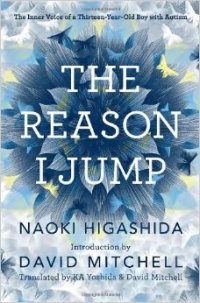Review of The Reason I Jump by Naoki Higashida

Carly Fleischmann’s story made headlines in 2008. Her parents thought she had little mental function; and then one day she figured out how to type. Among the first things she wrote was: “If I could tell people one thing about autism it would be that I don’t want to be this way but I am. So don’t be mad. Be understanding.” Her father said: “We were stunned. We realised inside was an articulate, intelligent, emotive person whom we had never met. Even professionals labelled her as moderately to severely cognitively impaired.”
The Fleischmann story fed into parents’ hopes and fears: their hopes that they could somehow unlock their child’s mind, and their fears that they were living with a stranger whose needs they could neither perceive nor satisfy. Many parents with autistic offspring wonder whether their non-verbal children are living in permanent psychic static. One such mother said: “If he were deaf and needed to sign, I’d learn Sign. But there’s no way for me to learn his language, because he doesn’t know it himself.”
The Reason I Jump is a Rosetta stone for these parents. Written by Naoki Higashida, a 13-year-old Japanese boy who cannot speak but has learnt to type, it is a disquisition on the autistic mind. The book is structured as a series of questions that a non-autistic person might ask an autistic one, and then provides the answers to those questions. It’s hard to believe that the person who wrote it could have been thought uncommunicative. Sometimes, it’s hard to imagine that he has a communication disorder, because his writing is eminently relational, even embracing, and always good-humoured. He describes behaviour that would seem to reflect a gross disability, but he does so with the charisma and finesse of someone who is very able indeed. Autism is sometimes associated with genius, but usually that is technical or mathematical genius. In this instance, the genius is social and even empathetic.
“True compassion is about not bruising the other person’s self-respect. That’s what I think, anyway,” he writes. Elsewhere: “Making sounds with your mouth isn’t the same thing as communication, right?” And then, “Please don’t assume that every single word we say is what we intended. This makes communication between us difficult, I know — we can’t even use gestures — but we really badly want you to understand what’s going on inside our hearts and minds. And basically, my feelings are pretty much the same as yours.” Parents and professionals are yearning for this information. Are the feelings of autistic people really the same as ours? Higashida makes a convincing case that they are, and a case for the difficulty of being an autistic person. Despite that agenda, he is never self-pitying or morose.
There is a certain pearls-of-wisdom quality to the writing. At its most banal, it seems to borrow from fortune cookies, as in the hackneyed parables Higashida inserts between his expositions. On other occasions, the pronouncements feel prophetic and evoke Mao’s Little Red Book in their aphoristic authority. And occasionally, Higashida hits profundity on the head, and in his wry pointillism he reminds me of Wallace Stevens’s “Thirteen Ways of Looking at a Blackbird.”
He explains the erratic movements that some autistic people produce, saying, “Both staying still and moving when we’re told to is tricky — it’s as if we’re remote-controlling a faulty robot.” Later he adds, “You can’t always tell just by looking at people with autism, but we never really feel that our bodies are our own. They’re always acting up and going outside our control. Stuck inside them, we’re struggling so hard to make them do what we tell them.”
Higashida give voice to rueful, sometimes embarrassed self-knowledge. He writes, “For people with autism, what we’re anxious about is that we’re causing trouble for the rest of you, or even getting on your nerves. This is why it’s hard for us to stay around other people. This is why we often end up being left on our own.” And then, poignantly, “Whenever we’ve done something wrong, we get told off or laughed at, without even being able to apologise, and we end up hating ourselves and despairing about our own lives, again and again and again. It’s impossible not to wonder why we were born into this world as human beings at all.”
Higashida’s description of the pain of autistic experience coexists with pride, and that is the book’s beauty, because he makes us long for his experiences. “Normal people think we’re highly dependent and can’t live without ongoing support, but in fact there are times when we’re stoic heroes,” he writes. And later, “Sometimes I actually pity you for not being able to see the beauty of the world in the same way we do. Really, our vision of the world can be incredible, just incredible …”
The book has been translated by David Mitchell (author of Cloud Atlas) and his wife, Keiko Yoshida, and Mitchell has written an impassioned introduction in which he discusses his experience with his own autistic child. The prose throughout the book is crisp, conversational, and intimate. I had to keep reminding myself that the author was a 13-year-old boy when he wrote this; sometimes, it sounds as though it were the work of a prudent adult pretending to be a 13-year-old boy, because the freshness of voice coexists with so much wisdom.
This book takes about 90 minutes to read, and it will stretch your vision of what it is to be human.











